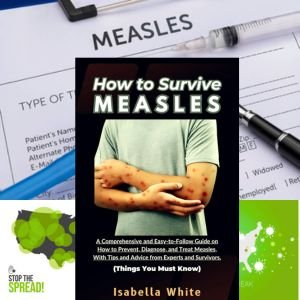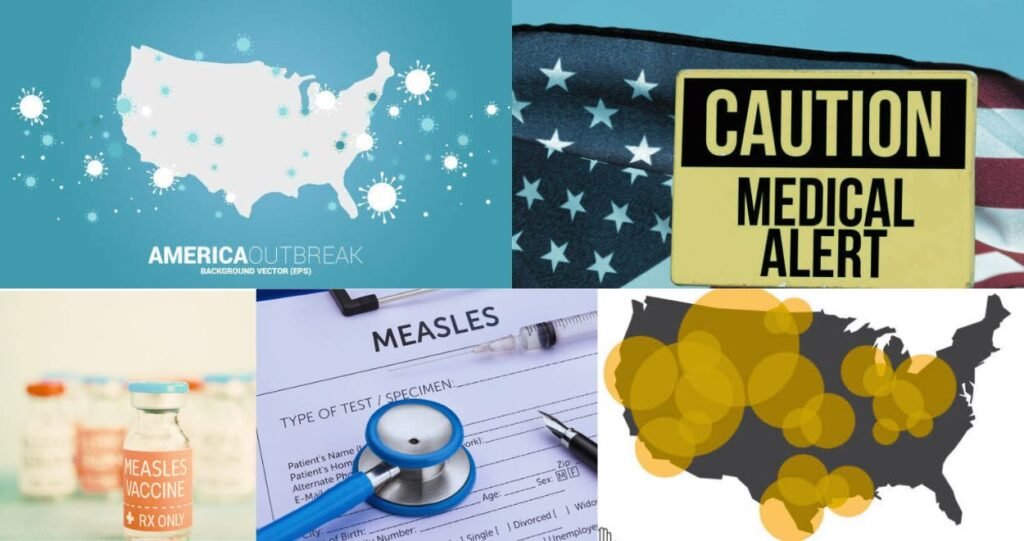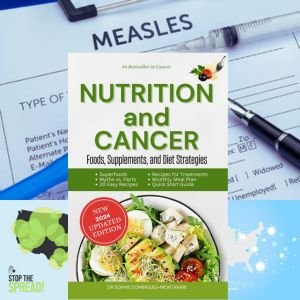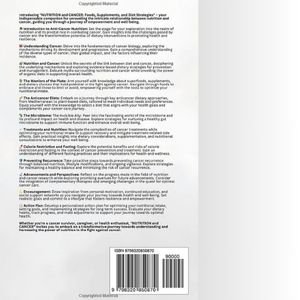The United States is currently grappling with a serious health issue as measles cases are on the rise. This disease, which had nearly disappeared from America, has made a significant comeback.
So, what’s going on right now?
Over 1,000 cases have been reported, marking 2025 as the second-most active year for measles since the year 2000. Texas is at the center of this outbreak, accounting for nearly two-thirds of all cases; however, other states are encountering issues as well.
The statistics paint a concerning picture. In 2024, health officials noted 16 outbreaks compared to just 4 in 2023—an alarming increase. Each outbreak signifies three or more connected cases in a single locality.
Currently, there are seven Texas counties where measles is actively spreading: Cochran, Dawson, Gaines, Lamar, Lubbock, Terry, and Yoakum. Health workers in the state are fighting relentlessly to curb the spread of this disease.
So, why should measles matter to us?
It’s more than just a skin rash; it can be deadly. This virus spreads faster than almost any other illness, with one infected person capable of passing it on to up to 18 others.
The symptoms begin gradually, starting with fever and cough, then transforming into telltale red spots across the body. While some individuals may fall seriously ill, others might not seem too affected at first.
Children below the age of five are particularly vulnerable, and adults over 20 face increased risks as well. Pregnant women should also take special precautions.

How to Survive Measles: A Comprehensive and Easy-to-Follow Guide on How to Prevent, Diagnose, and Treat Measles, With Tips and Advice from Experts and Survivors | Things You Must Know | Kindle Edition
by Isabella White (Author) | Format: Kindle Edition
The Deadly Truth About This Outbreak
The harsh reality about this outbreak is that three individuals have already lost their lives—one in Texas and the other two in New Mexico and Kansas, which includes an unvaccinated child. These tragic deaths could have been avoided with vaccination.
The situation in West Texas and New Mexico demonstrates just how quickly measles can spread. These areas alone have seen over 250 cases, with more surfacing every single day.
Health officials anticipate that the numbers will continue to climb, and they are working tirelessly to protect communities before it’s too late.
How Measles Spreads So Fast
This virus is sneaky—it travels through the air. When someone coughs or sneezes, they release tiny droplets that carry the disease. These droplets can linger in a room for hours, waiting for their next victim.
You don’t even have to be close to someone infected to catch measles. Simply breathing the same air as that sick person can be enough. The virus is incredibly potent, and about 90% of those who aren’t vaccinated will end up getting sick.
Places like schools, daycare centers, and airports can turn into hot spots. When large groups of people gather, the disease has the perfect opportunity to jump from one person to another in no time.
Vaccine Protection Is Dropping
In the 2021-2022 school year, around 93% of kindergarteners received their measles vaccines, a slight decline from 95.2% in 2019-2020. While this decrease might seem minor, it’s significant enough to allow outbreaks to occur.
The magic vaccination threshold is 95%. When the percentage dips below that, communities lose their protective shield. This lapse gives the virus a chance to find and infect unvaccinated individuals quickly.
Some parents opt out of vaccinating their kids, while others face challenges in accessing vaccines. Both situations create gaps in community immunity.
Why Measles Came Back
Even though measles was declared eliminated in 2000, we still see cases being imported because it’s still prevalent in many parts of the world. Travel helps bring the virus back to the U.S.
When vaccination rates slip, these incoming cases can trigger outbreaks as the virus spreads among unprotected populations.
Social media is also a problem, amplifying misinformation about vaccines. Unfortunately, some people fall for myths instead of listening to the science, which leaves children unvaccinated and at risk.
Global Picture Gets Worse
In the Americas, there’s been an 11-fold increase in measles cases compared to the same time last year, showing that this issue is escalating everywhere.
Countries with weak healthcare systems struggle to contain outbreaks, and these cases can easily make their way to the United States through international air travel.
The World Health Organization is closely monitoring global outbreaks. Their data indicates that measles is making a comeback on a worldwide scale.
What Symptoms to Watch For
When it comes to measles, there are a few symptoms you definitely want to keep an eye on. It all starts off like a common cold, with a high fever hitting first. After that, you can expect a cough and a runny nose to join the party, along with red, watery eyes that often tag along too.
About three to four days later, red spots will start popping up, beginning on the face and then spreading down the body. That rash can be pretty irritating, possibly itching or even burning at times, and fever may spike as high as 104 degrees.
Unfortunately, some individuals face more serious health complications. In fact, brain swelling occurs in about one out of every 1,000 cases, and pneumonia is another dangerous risk that can come into play.
Who Gets Sickest?
So, who ends up getting hit the hardest? The most vulnerable group includes babies under 12 months old, as their immune systems aren’t strong enough to fend off the virus. Many of these little ones might require hospital care.
Adults who haven’t had measles or vaccinations are also at risk of serious illness. Pregnant women, too, run the risk of losing their babies due to this infection. While generally, kids between one and five typically handle the illness better, they are still susceptible to severe complications
Treatment Options Are Limited
As for treatment, options are pretty limited. There isn’t a specific medication to cure measles. Instead, doctors focus on alleviating symptoms, which usually involves lots of rest and staying hydrated.
Vitamin A has been shown to help some children bounce back quicker, while pain relievers can help with fever and discomfort. In cases that are more severe, hospital care might be necessary. If breathing issues arise, special equipment could be required, and brain swelling demands urgent attention.
Prevention Still Works Best
The best way to avoid measles is through prevention. The MMR vaccine offers protection against measles, mumps, and rubella, and with two doses, it gives a whopping 97% level of protection—pretty much unbeatable.
Kids typically receive their first dose at 12 to 15 months old, and then again at 4 to 6 years old. Adults who aren’t vaccinated may need shots as well.
Rest assured, the vaccine is both safe and effective; serious side effects are quite rare, and the advantages of vaccination far surpass any potential risks.
Travel Increases Risks
When it comes to travel, the risk of measles isn’t something to overlook. Unvaccinated travelers can easily contract this virus while abroad and bring it back home to their communities.
Before you head out on your trip, make sure to double-check your vaccination status. If you need any shots, it’s best to get them at least two weeks in advance so your body has time to build up protection.
Popular tourist destinations can have active outbreaks, so it’s wise to review travel advisories before finalizing any plans. Keep in mind that some countries may require proof of vaccination for entry.
Schools and Daycare Centers
Schools and daycare centers can also act as hotspots for spreading measles, as children often play in close quarters and share toys, making it easy for the virus to pass from one little one to another.
Most schools have vaccination requirements for enrollment, but some states do allow exemptions. This poses a risk not only to the unvaccinated children but also to their peers. If an outbreak occurs, schools might have to close temporarily, which is a protective measure that can lead to challenges for working parents.
What Health Officials Are Doing
Health officials, like those at the CDC, are on top of the situation, tracking every case meticulously. They deploy teams to assist local health departments and use contact tracing to identify individuals who may be at risk.
In areas facing outbreaks, public health workers offer free vaccines and set up clinics in affected communities, while educational campaigns work to raise awareness about the associated risks. International collaboration is essential for monitoring global trends, providing an early warning system that helps prepare for possible imported cases.
Economic Impact of Outbreaks
Measles doesn’t just hit hard in terms of health; it also impacts the economy. Beyond medical expenses, businesses face worker shortages as people take sick leave, and school closures can force parents to miss work. Healthcare systems bear a hefty financial burden, as battling outbreaks requires significant resources, including extensive contact tracing and costly hospital care for severe cases.
Travel and tourism take a hit when news of outbreaks makes headlines, as people tend to shy away from affected regions, which in turn harms local economies.
How to Safeguard Your Family
First things first, check the vaccination records for everyone living under your roof. It’s crucial to ensure all of those shots are current. Don’t forget, adults often need booster shots too!
When outbreaks happen, it’s wise to steer clear of crowds if you or your loved ones aren’t fully protected. Keep your distance from anyone who seems unwell whenever you can, and make a habit of washing your hands regularly.
If you have any worries, have a chat with your doctor. They’re there to clarify any questions you might have about vaccine safety and can help make a solid protection plan for your family.
Looking Ahead
Combatting this outbreak calls for everyone to pitch in. We all have our roles to play. Vaccination stands out as the most significant step we can take.
Health experts anticipate more cases in the upcoming months, but acting swiftly can really help lessen the spread. A robust public health response can indeed turn the tide.
Our aim is to completely wipe out measles again, just like we did back in 2000. With enough determination, it’s entirely possible to achieve this once more.
Wrapping Up
This recent measles outbreak is a stark reminder that diseases thought to be gone can make a comeback. Over 1,000 cases were reported in 2025, showcasing just how rapid this virus can spread. Texas has seen the highest numbers, but other states are also experiencing challenges.
Tragically, three deaths highlight the lethal nature of measles. These were lives that could have been saved through vaccinations. The MMR vaccine offers impressive 97% protection when you receive both doses.
Vaccination rates are dipping below safe thresholds, laying the groundwork for potential outbreaks. International travel also brings the virus into communities that aren’t fully protected.
It’s essential for everyone to step up to halt this outbreak. Check your vaccination records and get the shots if you or your loved ones need them. Look out for yourself and your neighbors.
The battle against measles isn’t over yet. But with strong public health measures and community support, we can bring this outbreak under control. Together, we have the power to make measles a rarity once more in the United States.
Frequently Asked Questions
How can I tell if I’m protected against measles?
Take a look at your vaccination records. If you’ve had two MMR shots, you’re looking at about 97% protection. If you’re unsure, it’s always a good idea to check with your doctor for a blood test.
Can adults catch measles?
Absolutely. Adults who were born before 1957 probably had measles naturally and are protected. Others who haven’t had the vaccine will need to get vaccinated.
How long does someone remain contagious?
Individuals with measles can spread the virus from four days before the rash appears until four days after. They’re at their most contagious when their fever is at its peak.
What should I do if I’ve been exposed to measles?
You should reach out to your doctor immediately. If you’re unvaccinated, you might need special treatment. Keep an eye out for symptoms for the next 21 days.
Is the MMR vaccine safe for pregnant women?
No, pregnant women should avoid getting the MMR vaccine. It’s best to get vaccinated before pregnancy or after giving birth.
How effective is a single dose of the MMR vaccine?
One dose offers around 93% protection, but receiving two doses bumps that protection up to 97%. That’s why it’s important for kids to have both shots.
Can measles lead to long-term health issues?
Yes, it can cause serious complications like brain damage, hearing loss, and learning difficulties. Some kids might develop a rare brain condition years later.
What’s causing the drop in vaccination rates?
There are several reasons, including fear of side effects, misinformation spreading on social media, and challenges in accessing healthcare services.
How long does immunity from the vaccine last?
Most people enjoy lifelong protection from the MMR vaccines. However, some adults might require booster shots if blood tests reveal low immunity.
What occurs during a measles outbreak in schools?
Unvaccinated students may be prohibited from attending school, and some schools could close temporarily. Health officials will track exposures and provide.












